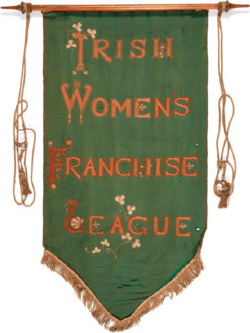Irish Women's Franchise League facts for kids
 |
|
| Formation | 1908 |
|---|---|
| Founder |
|
| Dissolved | 1918 |
The Irish Women's Franchise League (IWFL) was an important group in Ireland. It worked to get women's suffrage, which means the right for women to vote. This group started in Dublin in November 1908.
Some of its main founders were Hanna Sheehy-Skeffington, Margaret Cousins, Francis Sheehy-Skeffington, and James H. Cousins. Another member was Thomas MacDonagh. The IWFL also had its own newspaper called The Irish Citizen. This paper was published from 1912 to 1920. Francis Sheehy-Skeffington and James Cousins were the first editors. Lillian Metge, who started the Lisburn Suffrage Society, was a reporter for the paper.
Contents
Fighting for the Right to Vote
In the early 1900s, many people in power did not support women's right to vote. This included the Irish Parliamentary Party leaders, John Redmond and John Dillon. The British Prime Minister, Asquith, also did not support it.
Starting the League
In November 1908, Hanna Sheehy-Skeffington and Margaret Cousins, along with their husbands Francis and James, created the Irish Women's Franchise League. They wanted to make sure women's voices were heard.
Protests and Actions
The IWFL took strong actions to get attention for their cause. In June 1912, Hanna Sheehy-Skeffington and Margaret Cousins, with six other IWFL members, protested by damaging government buildings in Dublin. They were arrested and sent to jail.
The next month, Prime Minister Asquith visited Dublin. Francis Sheehy-Skeffington bravely spoke out at a meeting, demanding votes for women. He was then removed from the event. Outside, British women's rights activists Mary Leigh and Gladys Evans protested near Asquith's carriage. During this protest, John Redmond was accidentally injured.
The British women in jail started a hunger strike, refusing to eat. The Irish IWFL members joined them in solidarity. In March 1913, a statue of John Redmond was marked by a women's rights activist. This was to protest that the Irish Parliamentary Party did not support a bill for women's voting rights.
In contrast, James Connolly, a leader from Belfast, showed his support. He traveled to Dublin to speak at an IWFL meeting. Members of the ITGWU also helped by protecting the women as they left the meetings.
Facing Challenges
Hanna Sheehy-Skeffington lost her teaching job in 1913. This happened after she was arrested and jailed for three months for protesting at Dublin Castle. While in jail, she also went on a hunger strike. She was released for health reasons but was later arrested again.
The IWFL remained neutral on the issue of Home Rule for Ireland. However, they were against World War. After Francis Sheehy-Skeffington was executed during the Easter Rising of 1916, the League began to support Sinn Féin.
Efforts in the North
The IWFL found it hard to establish a strong presence in Northern Ireland. In August 1914, Christabel Pankhurst asked women's rights groups to stop their protests during the war. However, some members of the Women's Social and Political Union in Belfast, like Elizabeth McCracken and Margaret McCoubrey, looked to the IWFL for guidance.
In The Irish Citizen newspaper, McCracken questioned if the fight for voting rights should stop. She pointed out that men who had criticized women's protests were now asking women to support war. McCoubrey tried to start an IWFL branch in Belfast. However, differences between groups made it difficult, and her efforts ended in 1915.
The End of the League
In 1918, women over 30 in Ireland gained the right to vote. This was a huge success for groups like the IWFL. After this, and with big political changes happening in Ireland, the organization naturally lost its main goal. It soon stopped operating.
Key People in the League
Many dedicated people were part of the Irish Women's Franchise League:
- Mrs Charles Oldham was the first president.
- Mrs Hannah Sheehy Skeffington was the first secretary.
- Margaret Cousins was the first treasurer.
- Jenny Wyse Power joined around 1916.
- Cissie Cahalan served as president three times. She was one of the few working-class women in the movement.
- Rosamund Jacob was also a member.
- Marguerite Palmer was an honorary secretary.
- Marjorie Hasler joined in 1910. She was jailed for protesting and many believe her early death was a result of her time in prison. She is seen as "the first Irish martyr for the suffragette cause."
- Edith Young was active in the Galway branch.
- Lillian Metge was active in the Lisburn branch and a reporter for the Irish Citizen. She received a special medal after being jailed for a protest, but was released without a full sentence as World War One was about to begin.
- Patricia Hoey was the first president of the London branch of the IWFL.
- Alice Litster was an Irish women's rights activist whose experiences were recorded in interviews.
See also
- List of suffragists and suffragettes
- List of women's rights activists
- List of women's rights organizations
- Timeline of women's suffrage
- Women's suffrage organizations

